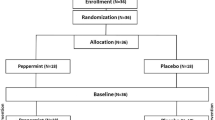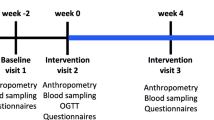Abstract
Red pepper spice (RP) and turmeric (TM) are used as flavorings in foods and for medicinal purposes. Utilizing a randomized, doubled-blinded, placebo-controlled, crossover design (2-week washout), 4-week supplementation with RP (1 g/d) or TM (2.8 g/d) was tested for influences on inflammation and oxidative stress in 62 overweight/obese (body mass index ≥ 27 kg/m2) females (40–75 years) with systemic inflammation (C-reactive protein, CRP ≥ 2 mg/l). Overnight, fasted blood samples were collected pre- and post-supplementation, and analyzed for oxidative stress (F2-isoprostanes, oxidized low density lipoprotein), inflammation (CRP and seven inflammatory cytokines), and metabolic profiles using gas chromatography–mass spectrometry with multivariate partial least square discriminant analysis (PLS-DA). Pre- to post-supplementation measures of inflammation and oxidative stress for both RP and TM did not differ when compared to placebo (all interaction effects, P > 0.05), and global metabolic difference scores calculated through PLS-DA were non-significant (both spices, Q2Y < 0.40). These data indicate that 4-week supplementation with RP or TM at culinary levels does not alter oxidative stress or inflammation in overweight/obese females with systemic inflammation, or cause a significant shift in the global metabolic profile.


Similar content being viewed by others
Abbreviations
- AIx@75:
-
Augmentation index normalized for a heart rate of 75 beats/min
- ANOVA:
-
Analysis of variance
- BMI:
-
Body mass index
- CRP:
-
C-reactive protein
- CV:
-
Coefficient of variance
- GC-MS:
-
Gas chromatography mass spectrometry
- IL:
-
Interleukin
- IFNγ:
-
Interferon gamma
- LDL:
-
Low-density lipoprotein
- PCA:
-
Principal component analysis
- PLS-DA:
-
Partial least square discriminant analysis
- RP:
-
Red pepper
- TM:
-
Turmeric
- TNFα:
-
Tumor necrosis factor alpha
- TRPV1:
-
Transient potential receptor vanilloid 1
References
Srinivasan K (2005) Role of spices beyond food flavoring: nutraceuticals with multiple health effects. Food Rev Int 21:167–188
Viuda-Martos M, Ruiz-Navajas Y, Fernández-López J, Pérez-Alvarez JA (2011) Spices as functional foods. Crit Rev Food Sci Nutr 51:13–28
Aggarwal BB, Harikumar KB (2009) Potential therapeutic effects of curcumin, the anti-inflammatory agent, against neurodegenerative, cardiovascular, pulmonary, metabolic, autoimmune and neoplastic diseases. Int J Biochem Cell Biol 41:40–59
Zhou H, Beevers CS, Huang S (2011) The targets of curcumin. Curr Drug Targets 12:332–347
Ahuja KD, Robertson IK, Geraghty DP, Ball MJ (2007) The effect of 4-week chilli supplementation on metabolic and arterial function in humans. Eur J Clin Nutr 61:326–333
Ahuja KD, Ball MJ (2006) Effects of daily ingestion of chilli on serum lipoprotein oxidation in adult men and women. Br J Nutr 96:239–242
Snitker S, Fujishima Y, Shen H, Ott S, Pi-Sunyer X, Furuhata Y, Sato H, Takahashi M (2009) Effects of novel capsinoid treatment on fatness and energy metabolism in humans: possible pharmacogenetic implications. Am J Clin Nutr 89:45–50
Tang M, Larson-Meyer DE, Liebman M (2008) Effect of cinnamon and turmeric on urinary oxalate excretion, plasma lipids, and plasma glucose in healthy subjects. Am J Clin Nutr 87:1262–1267
Baum L, Cheung SK, Mok VC, Lam LC, Leung VP, Hui E, Ng CC, Chow M, Ho PC, Lam S, Woo J, Chiu HF, Goggins W, Zee B, Wong A, Mok H, Cheng WK, Fong C, Lee JS, Chan MH, Szeto SS, Lui VW, Tsoh J, Kwok TC, Chan IH, Lam CW (2007) Curcumin effects on blood lipid profile in a 6-month human study. Pharmacol Res 56:509–514
Luo XJ, Peng J, Li YJ (2011) Recent advances in the study on capsaicinoids and capsinoids. Eur J Pharmacol 650:1–7
Tundis R, Loizzo MR, Menichini F, Bonesi M, Conforti F, Statti G, De Luca D, de Cindio B, Menichini F (2011) Comparative study on the chemical composition, antioxidant properties and hypoglycaemic activities of two Capsicum annuum L. cultivars (Acuminatum small and Cerasiferum). Plant Foods Hum Nutr 66:261–269
Reilly CA, Yost GS (2006) Metabolism of capsaicinoids by P450 enzymes: a review of recent findings on reaction mechanisms, bio-activation, and detoxification processes. Drug Metab Rev 38:685–706
Jurenka JS (2009) Anti-inflammatory properties of curcumin, a major constituent of Curcuma longa: a review of preclinical and clinical research. Altern Med Rev 14:141–153
Kim JH, Gupta SC, Park B, Yadav VR, Aggarwal BB (2012) Turmeric (Curcuma longa) inhibits inflammatory nuclear factor (NF)-κB and NF-κB-regulated gene products and induces death receptors leading to suppressed proliferation, induced chemosensitization, and suppressed osteoclastogenesis. Mol Nutr Food Res 56:454–465
Vareed SK, Kakarala M, Ruffin MT, Crowell JA, Normolle DP, Djuric Z, Brenner DE (2008) Pharmacokinetics of curcumin conjugate metabolites in healthy human subjects. Cancer Epidemiol Biomarkers Prev 17:1411–1417
Carlsen MH, Halvorsen BL, Holte K, Bøhn SK, Dragland S, Sampson L, Willey C, Senoo H, Umezono Y, Sanada C, Barikmo I, Berhe N, Willett WC, Phillips KM, Jacobs DR Jr, Blomhoff R (2010) The total antioxidant content of more than 3100 foods, beverages, spices, herbs and supplements used worldwide. Nutr J 9:3. doi:10.1186/1475-2891-9-3
Jungbauer A, Medjakovic S (2012) Anti-inflammatory properties of culinary herbs and spices that ameliorate the effects of metabolic syndrome. Maturitas 71:227–239
Zulyniak MA, Mutch DM (2011) Harnessing metabolomics for nutrition research. Curr Pharm Biotechnol 12:1005–1015
Belkacemi A, Doggui S, Dao L, Ramassamy C (2011) Challenges associated with curcumin therapy in Alzheimer disease. Expert Rev Mol Med 13:e34. doi:10.1017/S1462399411002055
Strimpakos AS, Sharma RA (2008) Curcumin: preventive and therapeutic properties in laboratory studies and clinical trials. Antioxid Redox Signal 10:511–545
Sharma RA, Steward WP, Gescher AJ (2007) Pharmacokinetics and pharmacodynamics of curcumin. Adv Exp Med Biol 595:453–470
Aravindaram K, Yang NS (2010) Anti-inflammatory plant natural products for cancer therapy. Planta Med 76:1103–1117
Lopez HL (2012) Nutritional interventions to prevent and treat osteoarthritis. Part II: focus on micronutrients and supportive nutraceuticals. PM R 4(5 Suppl):S155–S168
Evans AM, DeHaven CD, Barrett T, Mitchell M, Milgram E (2009) Integrated, nontargeted ultrahigh performance liquid chromatography/electrospray ionization tandem mass spectrometry platform for the identification and relative quantification of the small-molecule complement of biological systems. Anal Chem 81:6656–6667
Li Z, Henning SM, Zhang Y, Zerlin A, Li L, Gao K, Lee RP, Karp H, Thames G, Bowerman S, Heber D (2010) Antioxidant-rich spice added to hamburger meat during cooking results in reduced meat, plasma, and urine malondialdehyde concentrations. Am J Clin Nutr 91:1180–1184
Rajput S, Mandal M (2012) Antitumor promoting potential of selected phytochemicals derived from spices: a review. Eur J Cancer Prev 21:205–215
Patil SB, Ghadyale VA, Taklikar SS, Kulkarni CR, Arvindekar AU (2011) Insulin secretagogue, alpha-glucosidase and antioxidant activity of some selected spices in streptozotocin-induced diabetic rats. Plant Foods Hum Nutr 66:85–90
Davis PA, Yokoyama W (2011) Cinnamon intake lowers fasting blood glucose: meta-analysis. J Med Food 14:884–889
Funding
McCormick Science Institute
Author information
Authors and Affiliations
Corresponding author
Rights and permissions
About this article
Cite this article
Nieman, D.C., Cialdella-Kam, L., Knab, A.M. et al. Influence of Red Pepper Spice and Turmeric on Inflammation and Oxidative Stress Biomarkers in Overweight Females: A Metabolomics Approach. Plant Foods Hum Nutr 67, 415–421 (2012). https://doi.org/10.1007/s11130-012-0325-x
Published:
Issue Date:
DOI: https://doi.org/10.1007/s11130-012-0325-x




